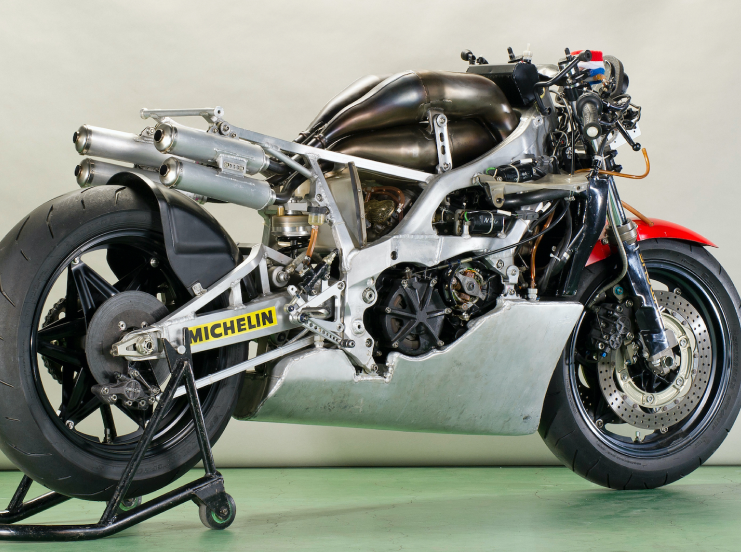A new press frame called "ULF" has been adopted for the NV0A racer.

This photo is the NV0A test bike No. 3 before the start of the 1984 season. The four exhaust chambers, where the fuel tank would be in a usual motorcycle, catch the eye. Honda tried the ULF (Ultra Light Frame) press frame for the first time on this test bike and the refined version on the NV0A racing machine. (Photo/SAN-EI)
The engineers first built a test bike to confirm the actual performance of the new machine on the circuit. It had the same chassis and engine as the NS500, but it was a motorcycle with a weight strapped to the bottom of the V3 engine. They conducted some running tests of this machine in April 1983.
In May, work began on a frame layout to mount the new V4 engine, designed since the previous month, and placement the fuel tank underneath. It was a test bike to verify the V4 and the upside-down layout, and to make it quick, its chassis was a double cradle frame with almost the same design as that of the NS500.
On September 12, HRC completed the first NV0A test machine in August and had been undergoing bench testing. It ran at the Suzuka Circuit for the first time with the V4 test engine mounted on this double cradle frame. It was the day after Spencer, who won his first WGP title at the San Marino GP, made a blessed participation in the final round of the All Japan Road Race Championship, winning by a landslide.

An illustration of the NV0A test bike No. 1 is based on document photographs and testimonies from those involved. A newly developed V4 test engine is mounted on a double cradle frame inherited from the NS500. It was the first bike to try an upside-down layout, with four exhaust chambers above the engine and a fuel tank hanging below it. (Illustration/Masaru Otsuka)
The NV0A test bike No. 2, which had a double cradle frame using square aluminum pipes but with different dimensions, was built in October. Spencer rode it in the Suzuka test from October 17 to 19. Up to this point, the double cradle frames were just for testing purposes to verify the characteristics of the newly developed V4 engine and the maneuverability of the upside-down layout. HRC had no intention of using the double cradle because they considered it was already an old-fashioned frame form for top-level road racers. Instead, they developed a new frame as well as the engine for the NV0A.
A prototype of the new frame was completed in November 1983. It had a girder made from press-formed aluminum parts that connected the steering head and swing arm pivot in a straight line. It was based on the ULF (Ultra Light Frame) concept that HRC promoted then.
Between November 1983 and January 1984, HRC conducted tests with the double cradle frame NV0A test bike No. 2 and the ULF press frame test bike No. 3 at Interlagos in Brazil, Surfers Paradise in Australia, and Daytona in the USA.
On January 31, they completed the NV0A as the practical racer, which had a further improved ULF press frame. After undergoing bench and domestic running tests, the finished machine left Japan as air cargo on February 25. The destination was the USA. The Daytona 200-mile Race held on March 11 was the debut race for the NV0A, also known as the first-generation NSR500.




